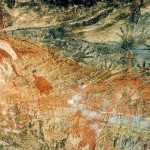 In Art and Intimacy, evolutionary anthropologist Ellen Dissanayake’s recent study of the relationship between art making and the “infancy of the human species,” she notes that meaning was first located in “what ‘felt right’—a full stomach, a safe environment, nearness of familiar others, or ways to acquire these.” Over a millennia of human evolution,
In Art and Intimacy, evolutionary anthropologist Ellen Dissanayake’s recent study of the relationship between art making and the “infancy of the human species,” she notes that meaning was first located in “what ‘felt right’—a full stomach, a safe environment, nearness of familiar others, or ways to acquire these.” Over a millennia of human evolution,
the mind increasingly became a “making-sense organ”: interrelated powers of memory, foresight, and imagination gradually developed and allowed humans to stabilize and confine the stream of life by making connections between past, present, and future, or among experiences and observations. Rather than taking the world on its own terms of significance and value (the basic survival needs, sought and recognized by instinct), people came more and more to systemize or order it and act upon it. Eventually this powerful and deep-rooted desire to make sense of the world became part of what it meant to be human—to impose sense or order and thereby give the world additional (what we now call “cultural”) meaning.
*Today’s post is part of a series of ideas, quotes and short provocations collected under the “What is this Thing Called Meaning?” banner. Please check backward for related and contextualizing entries.

“Over a millennia of human evolution”? That was quick!